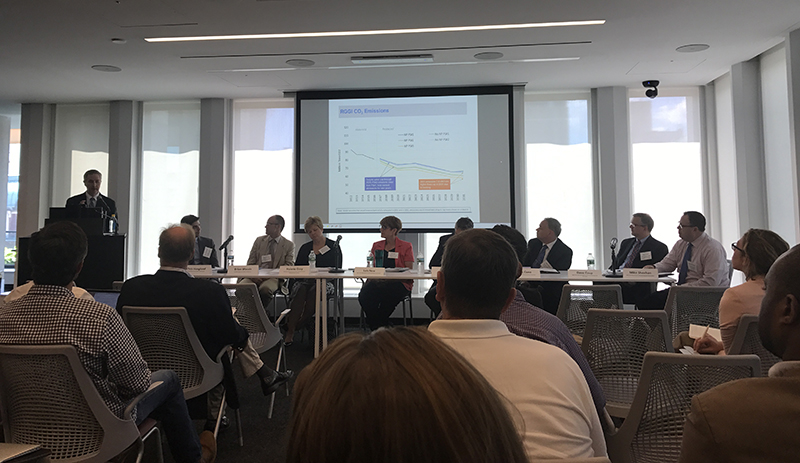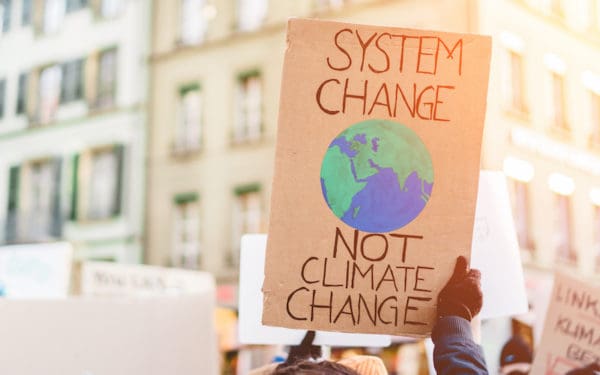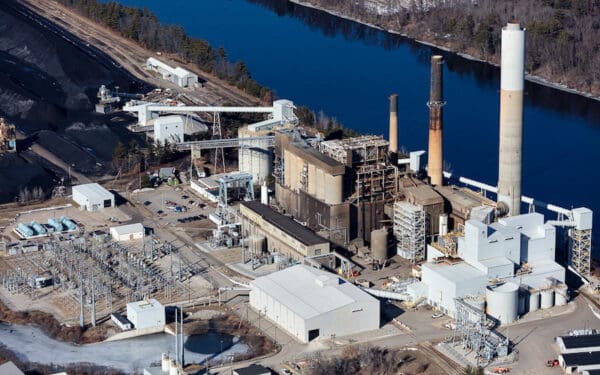
With the federal government stepping back, it’s up to states to lead the way on climate. Photo from RGGI meeting in NYC.
President Trump’s decision to withdraw from the Paris Climate Agreement has placed a renewed emphasis on local, state, and regional action on climate change. Just last month, 14 states – including four in New England – entered into the U.S. Climate Alliance, vowing to meet the goals of the Paris Agreement within their borders. The U.S. Conference of Mayors also adopted a resolution committing their cities to the Agreement at their recent meeting.
While these alliances developed, the nine mid-Atlantic and northeastern states that make up RGGI – the Regional Greenhouse Gas Initiative, a market-based program aimed at lowering greenhouse gas emissions – are in the midst of a program review. Now is a golden opportunity to strengthen the successful carbon trading program they pioneered and secure their role as leaders on climate action. (Carbon trading, also known as cap-and-trade, allows companies to buy and sell carbon “allowances,” which let them emit a certain amount of climate-warming carbon dioxide into the atmosphere. They can either use these allowances for their own regulatory compliance, or find ways to pollute less and then sell the allowances to someone else for cash. The proceeds from the sale of RGGI allowances are invested in consumer benefit programs, including energy efficiency and direct energy bill assistance.)
CLF helped to launch the RGGI program in 2009 and is actively participating in this latest program review. We are urging the nine RGGI states – Connecticut, Delaware, Maine, Maryland, Massachusetts, New Hampshire, New York, Rhode Island, and Vermont – to make ambitious changes to ensure that they meet their individual 2030 and 2050 targets for greenhouse gas emissions. CLF is also supporting state and regional action on climate change through our work to curb New England’s reliance on natural gas, supporting renewable energy initiatives, and pushing states to implement legally binding laws to slash their carbon pollution.
The Benefits of the Regional Greenhouse Gas Initiative
To date, RGGI has generated significant environmental, economic, and health benefits. The program has reduced emissions from the power sector by 45 percent and saved consumers $618 million on their energy bills. It has also created thousands of jobs along with more than $2.9 billion in regional economic growth. What’s more, by reducing emissions, it has prevented more than 8,000 asthma attacks, 39,000 lost work days, and 300 premature deaths.
The program is proof that curbing carbon emissions is not bad for business (despite what our current president and his fossil-fueled cabinet say). In fact, every New England state has seen big gains in economic growth since the program was implemented.
This program review offers the opportunity to reduce emissions even further, and ensure the program is working effectively. And now that Trump has stepped away from the Paris Accord, it’s the perfect chance for RGGI states to be the climate leaders the U.S. so desperately needs right now.
Strengthening Emission Caps and Fortifying Carbon-Cutting Methods
At the end of June, officials from the RGGI states and representatives from CLF gathered in New York City, where they discussed potential updates to the program. A critical outcome of the meeting was the realization among the member states that reducing emissions at a higher rate – and starting that push sooner rather than later – doesn’t cost more than reducing them more slowly or less aggressively. (If you’re interested in the models of potential changes in emission reduction tactics, see here under “June 27, 2017 Meeting Materials.”)
Some at the meeting had feared that updating the program with a more aggressive emissions cap would hurt businesses, but modeling out those scenarios proved that it wouldn’t be the case. With this in mind, CLF urged RGGI leaders to adopt the most ambitious emissions cap and strengthen the program’s other methods for lowering greenhouse gas emissions.
In addition, CLF and others have called on the RGGI states to:
- Adopt the most ambitious declining annual cap on carbon. This means lowering the amount of carbon emissions a company can produce per year, and reducing that amount each year starting in 2019. By establishing a lower cap and ambitious trajectory, the RGGI states can reduce emissions more quickly, set themselves up to reach their climate goals, and set an example for other states.
- Adopt programs and reforms to make RGGI stronger. Since cap-and-trade programs work on a supply-and-demand model, the program is only effective if carbon allowances are priced high enough to create emissions reductions, but low enough to prevent compliance from being cost-prohibitive. So RGGI should stop low-priced allowances from building up, as well as remove any “banked,” or extra, allowances that could skew this supply-and-demand system.
- Explore opportunities to expand the RGGI program. There is great potential for RGGI to expand into new states, like Virginia or former RGGI-member New Jersey, or to link with other markets, like California. Larger markets would create more flexibility, expand opportunities for cost-effective emissions reductions, and raise more money that could be reinvested in the program.
- Conduct an environmental justice analysis. This analysis should dive into the impact that RGGI programs like carbon emissions caps will have on communities that are overburdened by pollution. To date, the RGGI states have done little to assess the program’s impact of environmental justice communities. The proposed analysis will provide the RGGI states the tools to properly assess the implications of their policy decisions on all people, including those with increased vulnerability to the impacts of climate change.
Ensuring Continued Climate Leadership
In the increasing void of federal action on climate change, local and state governments need to take action to reduce climate-damaging emissions. Programs like RGGI can allow them to take leadership role in both implementing new programs and strengthening existing ones.
CLF commends RGGI on its success to date, and urges the participating states to build on this by implementing the most ambitious cap and program modifications possible in the final stages of its program review. CLF will continue to actively participate in the review and advocate for continued climate leadership from RGGI.



